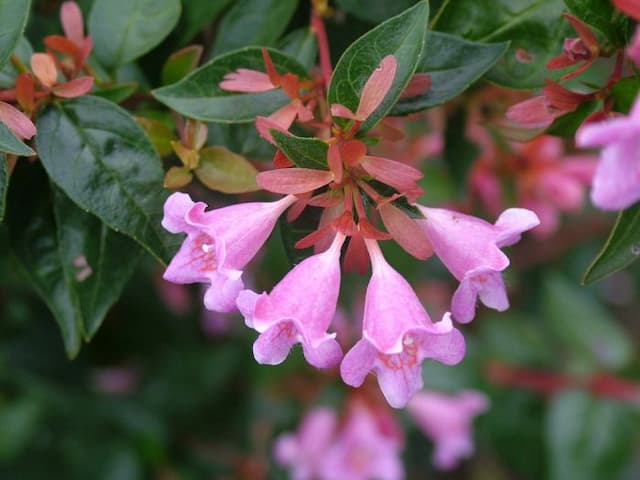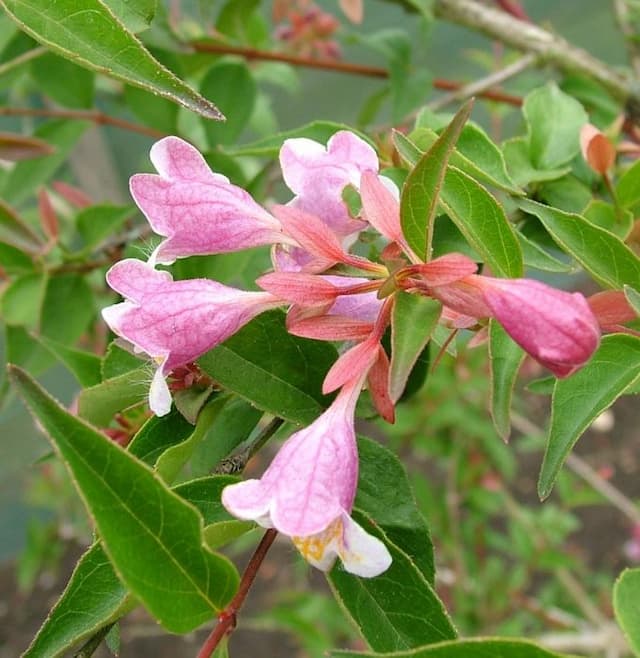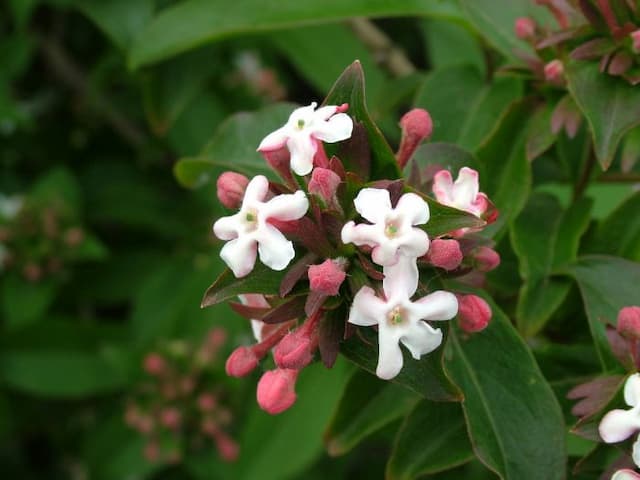Delavay's Honeysuckle Lonicera similis var. delavayi

ABOUT
Lonicera similis var. delavayi, also known as the "Delavay's Honeysuckle," is a plant distinguished by its attractive features, which make it a favored specimen in gardens. This plant is characterized by its twining stems, which enable it to climb structures or spread across the ground, depending on the support it receives. The leaves of Delavay's Honeysuckle are oval to rounded in shape, with a glossy green surface that appears slightly blue-green beneath. They are arranged oppositely along the stems, providing a dense and lush foliage that can create a thick coverage. One of the most striking aspects of this plant is its flowers. They are tubular, with flaring, lip-like ends that open to reveal the interior. These blossoms are typically a creamy white to pale yellow color, often with a hint of pink or purple on the outside, and are noted for their sweet, enticing fragrance which can attract pollinators such as butterflies and bees. After flowering, the plant produces small, round berries. The berries may be red, black, or blue when ripe, adding an additional layer of visual interest to the plant after the flowering season has passed. Overall, Delavay's Honeysuckle is highly valued for its ornamental qualities, including its appealing flowers, delightful scent, and the dense coverage of its foliage, which can create a natural green backdrop or an attractive overlay on trellises, fences, and other garden structures.
About this plant
 Names
NamesFamily
Caprifoliaceae
Synonyms
Delavay's Honeysuckle, Evergreen Honeysuckle, Winter-Flowering Honeysuckle
Common names
Lonicera delavayi, Caprifolium delavayi.
 Toxicity
ToxicityTo humans
The Lonicera similis var. delavayi, commonly known as the Chinese honeysuckle, is not widely known for being toxic to humans. However, as with many plants, it is possible that some individuals may experience mild stomach upset, vomiting, or diarrhea if they ingest parts of the plant, especially in large quantities. It's always advisable to avoid eating plants that are not confirmed to be safe for human consumption.
To pets
For pets, specifically dogs and cats, the Chinese honeysuckle may cause mild to moderate gastrointestinal upset if ingested. This can include symptoms such as vomiting, diarrhea, and abdominal pain. While not considered highly toxic, it is still best to prevent pets from consuming the plant to avoid any potential discomfort or health issues. If you suspect your pet has ingested part of the plant and is showing symptoms, it is recommended to contact a veterinarian.
 Characteristics
CharacteristicsLife cycle
Perennials
Foliage type
Deciduous
Color of leaves
Green
Flower color
White
Height
10 feet [3 meters]
Spread
6 feet [1.8 meters]
Plant type
Shrub
Hardiness zones
7
Native area
China
Benefits
 General Benefits
General Benefits- Aesthetic Appeal: Adds visual interest to gardens with its lush foliage and fragrant flowers.
- Attracts Wildlife: Provides nectar for hummingbirds, butterflies, and beneficial insects.
- Privacy Screen: Can be used as a living fence or screen, offering privacy to outdoor spaces.
- Erosion Control: Its root system helps stabilize soil on slopes and prevent erosion.
- Drought Tolerance: Once established, it is relatively drought-resistant, reducing the need for frequent watering.
- Low Maintenance: Generally requires little care once it is established in the right conditions.
- Versatility: Suitable for a variety of landscaping designs, from formal to wild gardens.
- Seasonal Interest: Offers year-round interest with evergreen foliage, flowers in summer, and sometimes colorful berries in fall.
 Medical Properties
Medical Properties- Antibacterial: Lonicera similis var. delavayi has been used in traditional medicine for its antibacterial properties, potentially inhibiting the growth of certain bacteria.
- Anti-inflammatory: Some compounds found in the plant may help reduce inflammation.
- Antioxidant: The plant is believed to contain phenolic compounds, which possess antioxidant properties that may protect cells from oxidative stress.
- Antiviral: Lonicera similis var. delavayi may exhibit antiviral activity against certain viral strains.
- Soothing for the respiratory system: Traditional uses include the plant being used as a remedy for respiratory conditions.
- Diuretic: There may be diuretic effects associated with the plant, traditionally used to increase urine production and alleviate fluid retention.
 Air-purifying Qualities
Air-purifying QualitiesThis plant is not specifically known for air purifying qualities.
 Other Uses
Other Uses- Lonicera similis var. delavayi, also known as Delavay's honeysuckle, can be used in landscaping to create hedges or privacy screens due to its dense growth.
- As an ornamental climber, Delavay's honeysuckle is well-suited for growing over arbors, trellises, or pergolas, adding vertical interest to gardens.
- The fragrant flowers are useful for attracting pollinators such as bees and butterflies, enhancing the health and beauty of a garden ecosystem.
- The plant can be incorporated into sensory gardens, where its sweet fragrance contributes to the sensory experience.
- Its twining vines can be trained on fences to add natural beauty while also providing subtle cover-up for unsightly areas.
- Delavay's honeysuckle can be used in slope stabilization, where its root system helps to prevent soil erosion on inclines.
- The plant's dense foliage can serve as a backdrop in floral arrangements, adding greenery and structure to bouquets.
- During seasonal celebrations, particularly in winter, its evergreen leaves can be used to create festive wreaths and garlands.
- By planting Delavay's honeysuckle near patios or windows, one can enjoy its pleasant aroma when sitting outdoors or through open windows.
- Its berries, while not edible, can add visual interest in the garden during the autumn and winter months when other plants may have died back.
Interesting Facts
 Feng Shui
Feng ShuiThe plant Chinese Honeysuckle is not used in Feng Shui practice.
 Zodiac Sign Compitability
Zodiac Sign CompitabilityThe plant Chinese Honeysuckle is not used in astrology practice.
 Plant Symbolism
Plant Symbolism- Love and Devotion: Commonly known as 'Honeysuckle,' Lonicera similis var. delavayi shares the symbolism of other honeysuckle varieties, representing bonds of love and the affectionate ties between people because of its entwining growth habit.
- Sweetness of Life: The sweetly scented flowers of the Honeysuckle are often associated with the pleasant experiences and joys in life.
- Innocence: Honeysuckle blooms are delicate and can represent the purity and innocence of nature and in human relationships.
- Happiness: With its vibrant growth and attractive flowers, Honeysuckle is also symbolically tied to creating happiness in the home where it grows.
- Generosity: As honeysuckles are known for their abundant nectar, they can also symbolize generosity and the willingness to give to others.
 Water
WaterThe Chinese honeysuckle needs regular water to keep its soil evenly moist, especially during the growing season. Water it deeply once a week, providing about 1 to 1.5 gallons of water for medium-sized shrubs; this ensures that the moisture reaches the roots rather than just wetting the surface. The amount of water may need to be increased during hot, dry spells. However, it's crucial to ensure that the plant is not left in standing water, as this can lead to root rot. During winter, reduce watering as the plant's growth slows down and it requires less moisture.
 Light
LightThe Chinese honeysuckle thrives best in full sun to partial shade conditions. A spot that receives morning sunlight and is shaded in the hotter part of the afternoon is ideal. This sun exposure ensures adequate light for growth while protecting the plant from the intense heat of the late afternoon, which can sometimes be too harsh, especially in warmer climates.
 Temperature
TemperatureChinese honeysuckle prefers a temperate climate with temperatures ranging from about 60°F to 75°F for optimal growth. It can survive in temperatures as low as 20°F and as high as 80°F, but prolonged exposure to temperatures outside its comfort zone can stress the plant. Ideally, maintain a stable environment to avoid subjecting the honeysuckle to extreme temperature fluctuations.
 Pruning
PruningPruning the Chinese honeysuckle ensures it maintains a desired shape and promotes healthier, more vigorous growth. Prune in late winter or early spring before new growth starts. Cut back by about one third of the previous season's growth to keep the shrub tidy and to encourage new shoots. Deadheading or removal of spent flowers can be done as needed throughout the growing season to improve the plant’s appearance.
 Cleaning
CleaningAs needed
 Soil
SoilFor the Evergreen Honeysuckle (Lonicera similis var. delavayi), the best soil mix is well-draining, fertile, and humus-rich, with a pH between 5.5 and 7.5. A blend that includes equal parts garden soil, compost, and perlite or coarse sand would provide the texture and nutrients necessary for proper growth.
 Repotting
RepottingThe Evergreen Honeysuckle should be repotted every 2 to 3 years during its active growing season, which is generally in the spring. Frequent repotting is not necessary as the plant tolerates being slightly root-bound.
 Humidity & Misting
Humidity & MistingThe Evergreen Honeysuckle thrives in moderate to high humidity levels. A range of 40-60% is ideal for this plant. Avoid placing it in areas with very dry air or near air vents which can reduce humidity.
 Suitable locations
Suitable locationsIndoor
Place in bright, indirect light, ensure good humidity, and avoid dry air.
Outdoor
Plant in partial shade, shelter from harsh winds, mulch, and water regularly.
Hardiness zone
7-9 USDA
 Life cycle
Life cycleThe Lonicera similis var. delavayi, commonly known as the Delavay's Honeysuckle, starts its life cycle as a seed, typically dispersed by birds or gravity close to the parent plant. Upon germination, which requires a period of cold stratification to break dormancy, the seedling develops a root system and shoots, and enters the vegetative growth phase, characterized by the production of leaves and stems. As the plant matures, it reaches the flowering stage, usually in early summer, producing fragrant white to yellow flowers that are attractive to pollinators. Following pollination, the flowers develop into small red berries, which are consumed by birds, aiding in seed dispersal. In favorable growing conditions, Delavay's Honeysuckle can become a perennial woody vine, exhibiting seasonal growth and dieback over many years. As a climber, it may need some support or it can spread across the ground, contributing to its vegetative expansion and longevity.
 Propogation
PropogationPropogation time
Spring-Early Summer
Propogation: The Chinese honeysuckle, Lonicera similis var. delavayi, is most commonly propagated through semi-hardwood cuttings. This method involves taking cuttings from the plant during the summer, when new growth is somewhat mature but still flexible. Cuttings should be 4 to 6 inches long, with excess leaves removed from the lower half. The cut end is often dipped in rooting hormone to encourage root development and then placed in a well-draining soil mixture. The cuttings must be kept moist and in a warm environment to facilitate rooting, which typically occurs within a few weeks. After roots have formed, the new plants can be transplanted to their final location. This method is popular for its simplicity and high success rate.







![Himalayan honeysuckle [Golden Lanterns]](/_next/image?url=https%3A%2F%2Fplants-admin.emdemapps.com%2Fimages%2Fplants%2F%2Fimages%2F604b55302cc87.png&w=640&q=75)

